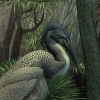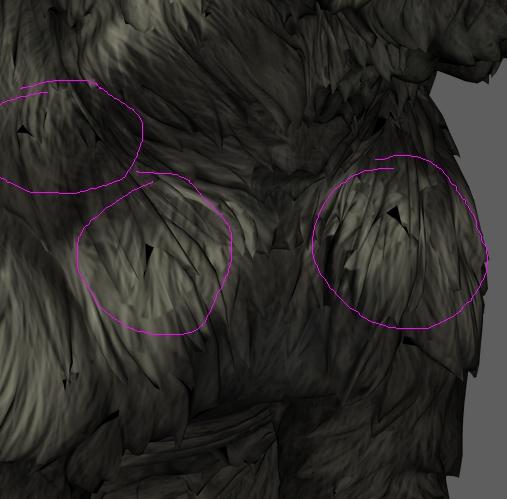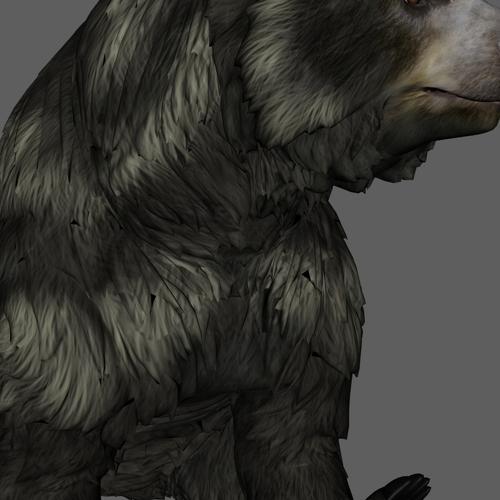RESOLVED - Some mesh poly's not taking texture
 nowefg
Posts: 557
nowefg
Posts: 557
This model was created for Poser, according to the artist/vender. It's an interesting approach to fur, I thought.
You can see in the screenshot that several mirrored polygons in the mesh appear black, in any orientation, so it isn't a lighting issue.
They're not missing, as they can be selected and hidden, in which case the back of the model can be seen through the "hole."
So the poly's are there, but for some reason aren't taking any texture from the map.
Any ideas about what's happening?
It's a great model of a primitive bear, but most every pose and angle shows this issue, and I'd rather fix it than postwork every render I use this one in.


Bears_holes_2_B.jpg
507 x 499 - 157K


Bears_holes_2.jpg
800 x 800 - 295K
Post edited by nowefg on


Comments
Looks like ngon's (none Quad) mesh issue. Some Ngon's cause errors in DAZ Studio.
Thanks, Jaderail,
You mentioned this ngons thing in another recent 'problem' post of mine.
How, where, can I learn more about this ngon thing? Like a workaround?
It's not just ngon that do this, quad polygons will also do it, what your looking at is a concave (aka non-convex) polygon, when DS does it's internal triangulation of a mesh these can cause it problems, which results in the normal being broken and a broken normal displays as black in DS.
Ah!! Yes the normals could be out as well. I forget they can cause texture issues in small areas as well.
Thanks, Bejaymac,
I basically follow this. Would you know the purpose of a quad polygon or ngon? Why would such a beast be part of mesh in the first place?
Would a problem like this be solvable by opening the model in Poser and exporting it out in some other way, format, something-or-other that daz has less trouble with?
I ask because Poser 9 is still on sale for 29 bucks, and I was thinking to get it, to explore other poser-only related problems.
Polygons (tri, quad or ngon) are a major part of any mesh, without them all you have are a pile of vertices (dots) with no place to put a texture.
We have two ways to deal with this in DS, first one has been available since half way through DS3's life, it's called "triangulate" and you'll find it under "Edit > Object > Geometry", this will convert all of the quad & ngons into tri polygons (3 sided).
The second is to use the Convert to SubD on the mesh, then in the parameters tab set the resolution back to base.
Excellent! Thanks, Bejaymac.
On the poly type thing, what I was wondering about was that if the problem poly's are quad (or ngon), why would they be included at all, as opposed to only using the type of poly's that are not problematic, here. Is there some special purpose or application for these quad and ngon polygons, that sort of thing.
These are very basic questions, I'm sure, but in line with my interests. Thanks for passing along some solutions to try.
Tri (triangle meaning it has 3 verticies and 3 edges making on polygon) Quad 4 and a ngon have more than 4. Daz Studio and many other programs see Quad and Tri better than ngons, generally speaking.
So if they are ngon then Daz Studio is going to have a hard time. Not sure if Poser can see ngons properly. But Bejaymac. advice could work.
If it is a Normal issue (normal being the direction the ploygon is facing, outward is correct, facing inward incorrect, again generally speaking) then the only option is to take the Mesh in to Say Blender or Hexagon and Recalulate Normals outside. I know Blender better and is can be done in seconds. Then reimport the mesh back into Daz Studio. If it is a ngon issue the you would need to use Blender's remove ngon feature and hope for the best, the last resort would be to adjust each ngon manually in Blender and that I wouldn't like to do. :)
Most modeling programs don't show issues like this, so the creator is usually unaware that anything is wrong with their mesh, it's not until that mesh is loaded into another program that the issues appear, you could probably send that mesh to hexagon and not be able to find the problem polygons, done that myself often enough :).
The problem of the "Black Poly" is an old one in DS, I've complained about it often enough :P , the problem is to do with the shape of the polygon, and how DS does it's internal triangulation of the mesh before it sends it to the viewport. If the quad poly and/or ngon are convex then DS has no problems with it what so ever, but if it's concave or non-convex (borderline between the two) then that's when DS can have problems with it's triangulation.
In the attached image, you see a quad polygon, the 4 "dots" are vertices and the 4 black lines are the "edges", this polygon is concave, you can tell that by the internal angle of the two black edges at vertice 4 being greater than 180 degrees, and by the fact I coloured it yellow :D. Now normally during internal triangulation this quad polygon would be split into two tri polygons, the split would normally be along the broken blue line between 2 & 4, this is also how the normals are set up, however as this is a concave polygon DS has a very good change to split it between 1 & 3 instead, which is not how the normals are set up, the result is broken normals and a black polygon.
Nice info...I had no idea, now I do thanks
Excellent twice!
Thanks Szark and Bejaymac, and Jaderail. I have Blender and can try that too, but the whole discussion is really helpful and appreciated.
I'm very curious to look at the model again, with all this in mind.
If you need help in Blender just shout.
Thanks, Szark, I certainly will.
Just remember I am in the UK but I am willing to take some screenshots and guide you through. To be honest it is that simple text would do just fine.
Bingo. Big thanks for the help with this, Bejaymac, Szark, and Jaderail !
Triangulate and SubD both fixed the issue, so I can use this model without concerns about time consuming postwork.
Interestingly, when I saved the "triangulated" model, thinking to save a step next time, reloading that saved set brought an even weirder visual problem! It's not a problem, of course; triangulate only takes a few seconds to fix a fresh cr2 each time I load this model.
With SubD, resolution set to base, the "holes' reappear, so I'm guessing that I would use base to setup, and High Resolution at render time?
I really appreciate everyone's input on this question. It's a highly stylized bear, but I originally saw interesting possibilities for it, and solving this problem got those creative thread moving again.
SZARK!, (shouting, like you said),
I'm thinking to try the Blender route on this, as well. I can import/export, and manipulate the model in the Blender viewport. Been working a bit on extruding, etc, with the guidance of the 2-Minute-Blender videos on YouTube.
Without going to a lot of trouble, can you fill me in on how to re-normal the model once I've got it in Blender?
Also, will I lose the morphs and poses, etc. if I import/export via Blender? I haven't tried this yet, but seem to recall issues like that with other models that I tried to work with in Blender and then send back to Studio.
Thanks again for offering to share your expertise. There's no pressure on this end, as I can work with this model, now, but I'd like to know more about using Blender to fix things. Every little bit moves the larger project forward.
Ok if you are familair with Blender then this will be easy. ;)
In Object Mode select the Bear, if is has multiple parts then you may have to do each one at a time or you could Join them as one. Whatever you choose select a part/or whole and go...
.
..in toEdit Mode (tab) then press the N key to bring up the side Properties box panel, if not already visable, and scroll down the Mesh Display > Normals and see two small icons under the word Normals. One for Vertices and one for Faces. Click the Faces icon and your normals wiil show as Cyan colored lines. If they don't show increase the size with the scale box to the right of those two icons. This is a just a visual refernce as a guide so yoiu can see the Normals.
Selelct all the Polygons A to selected everything and hit Ctrl N on the keyborard. Or in the Menu bar of the working window go to Mesh > Normals > Recalculated Outside.
And no Morphs and movemet will not be retainded when you export the mesh from Daz Studio.
Great ! Thanks, Szark !
Question: How does one get these morphs and poses back? If every exported model has to be re-rigged and mapped, every time,
it seems not worth messing with. But, I know many people do. On an articulated model with limbs and toes, it's a lot of bones to lose each
time, not to mention the subtle morphs like snarl and eyes wince. I don't imagine I could reproduce these morphs at all.
Would you know if there a DS technique for getting morphs etc back into an imported model?
Yes a PITA if you want to do a few images or animations using different poses so yes it would have to be rerigged once and hten saved as a scene at the final stage.. You don't need to remap it, as exporting will preserve the UV maps if no extra geometry has been added in Blender etc..
However if you are doing a simgle image, pose the figure before exporting. :)
Okay. So...
what about just using those new, re-normaled maps? applying them to the existing model? No, because the normals problem is with the mesh, not the map, right?
So, what about using the existing model as the morph, and applying that, with the new model as the morph target? Transfer existing morphs... something. I mean, if I can export a model, morph it, and then bring it back in an use it as a morph... I know folks do do that.
Seems there oughta be a way, short of a complete re-rig PITCaboose.
Shows how little I know about any of this, I'm sure.
Thanks, again, Szark.
Yes coorect you are adkusting the Normals of the mesh, you are not doing anything to the UVmaps. The only time you will upset the UVmapping is if you add more geometry i.3 more polygons.. Even if you Tiriangulate the mesh in Blender you will still preserve the UVmaps.
I don't knw anything about Morph loading etc sorry.